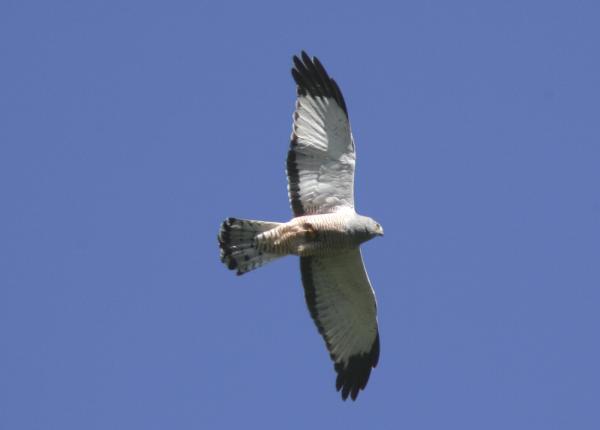Did You Know?
- The word "cinereous" means ash-gray, especially when referring to the color of fur or feathers
- The population of Cinereous Harriers once found on the Falkland Islands is nearly gone
- Researchers have seen evidence that male Cinereous Harriers are polygamous - meaning they will mate with more than one female during the same breeding season.
How The Peregrine Fund is Helping
Though The Peregrine Fund does not work directly with Cinereous Harriers, our efforts in scientific research, habitat conservation, education, and community development help conserve birds of prey around the world. We also supply literature to researchers from our avian research library, which helps scientists around the world gather and share important information on raptor conservation. Our work with the Neotropical Raptor Network helps conserve raptors by fostering collaboration and communication among raptor enthusiasts in the region. And, finally, our support of the Global Raptor Information Network gives raptor researchers tools to more efficiently conduct their own studies while contributing to a global program. It also provides citizen scientists a way to participate in raptor science and conservation.
Where They Live
This beautiful harrier is found in parts of South America. It can be seen gracefully quartering over grasslands, savannas, marshes, wetlands, foothills, arid shrublands, agricultural fields, and even along coastlines in some parts of its range. It is found in parts of Colombia, Ecuador, Peru, Bolivia, and Argentina. It is rarely seen on the Falkland Islands.
What They Do
Both the male and female Cinereous Harriers are strikingly beautiful. Like many other harrier species, the male and female differ in plumage characteristics. The males are overall a dark gray, and the tips of its wings are dark black, which are easily visible in flight. The females are overall more brown above. They both have rusty streaking on the breast and white rumps.
These harriers are diurnal and can often be seen flying low over open areas in search of food. Some populations of this harrier are resident - meaning they remain in the same area all year round, while others are migratory. However, scientists still have a lot to learn about the movements patterns of this lovely bird.
Why They Need our Help
The Cinereous Harrier is categorized as a species of Least Concern. This means that conservationists aren't too worried about the future of this bird. Thankfully, it has a relatively wide range and is fairly common. While in some areas their population is decreasing - likely due to the use of pesticides, shooting, and the destruction of their habitat - they are increasing in other areas.
What They Eat
This stunning raptor will feed upon a number of different prey. It will catch rodents, small birds, frogs, reptiles, insects, and arachnids! The hunting style of a harrier is unmistakeable. They fly in a teetering motion low over open areas, such as marshes or grasslands, with long glides between a short series of wingbeats.
Nests, Eggs, and Young
Like many other harriers, the Cinereous Harrier nests on the ground. The nest is built of grasses, rushes, and reeds. Harriers build their nests directly in grass or sometimes on platforms among the reeds in marshy areas.
The female will lay 3-5 eggs, which are pale blue or bluish-white and unmarked. Once the eggs are laid, the female will take on all of the incubation duties. For the next 28-32 days, she will spend most of her time sitting on her eggs, keeping them at just the right temperature so that the embryos can develop into healthy nestlings. Even before the young can fly, they might leave the nest to hide among the grasses and reeds. After about a month, they will be ready to fly for the first time.
This species is territorial and will defend its nest against potential predators.
Cinereous Harrier and the World Center for Birds of Prey
The World Center for Birds of Prey is far from the Cinereous Harrier's range, however, there is another harrier, the Northern Harrier, that can be seen around the center at times. As you drive up to the entrance, watch for them soaring low over the grassy fields on either side of the road. When walking our nature trail, be sure to look for these graceful, agile raptors. An interpretive sign at the end of the trail teaches you how to identify a raptor based on its silhouette. Inside the center, there are opportunities to learn about other birds of prey through interactive activities, videos, touch tables, exhibits, and a chance to meet some of our Avian Ambassadors up close!
References:
Bierregaard, R. O., G. M. Kirwan, P. F. D. Boesman, and J. S. Marks (2020). Cinereous Harrier (Circus cinereus), version 1.0. In Birds of the World (J. del Hoyo, A. Elliott, J. Sargatal, D. A. Christie, and E. de Juana, Editors). Cornell Lab of Ornithology, Ithaca, NY, USA. https://doi.org/10.2173/bow.cinhar1.01
Global Raptor Information Network. 2022. Species account: Cinereous Harrier Circus cinereus. Downloaded from http://www.globalraptors.org on 29 Mar. 2022
Saggese, M. D.; De Lucca, E. R. (1995) Reproducción del Gavilán Ceniciento Circus cinereus en la Patagonia argentina. Hornero 014 (01y02) :021-026










